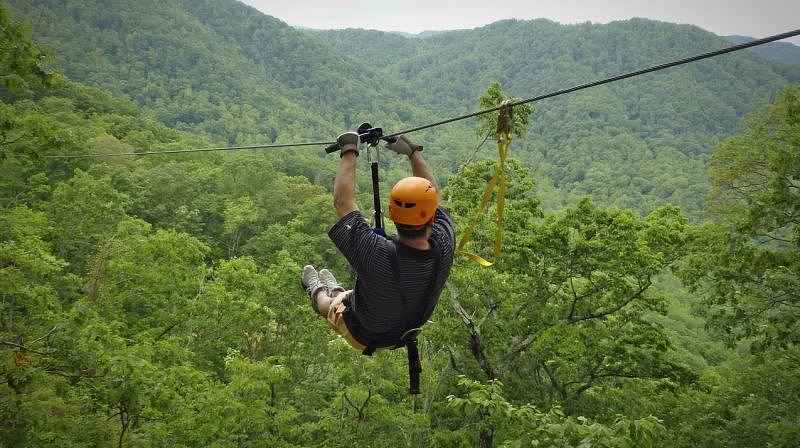






See listing of Recent and Most Popular articles on the Home Page
Travel
Category: Sports & Recreation / Topics: Leisure • Lifestyle, General • Media • Sports • Statistics • Travel
Zip Risk?
by Stu Johnson
Posted: December 4, 2015
Seeking an adventure? Zip-lining may be attractive (not just for the young), but how should you interpret reports of the risk?…
This article appeared as an entry on Stu's InfoMatters blog (see link below). While the emphasis is on the reporting of risk, you may find it informative if you have considered pursuing this adventurous sport.
It’s a rush. The wind in your face. The adrenaline. The fear and then the excitement of flying down a zip line, suspended high above the ground. But, is it safe? The other day, an article by AP Medical Writer Lindsey Tanner appeared in the Health & Fitness section of our local paper. The headline urged “Think twice before zip-lining on vacation. Popularity soars along with injuries.” [1]
On digging a little deeper, the headline is both true and potentially misleading. Before I talk about the reporting and interpretation of the statistics, however, let me share my own experience with zip lining and the concept of perceived risk.
A personal perspective
For ten years in my early days as a faculty member at Wheaton College in Illinois, I was involved with what was then called the Vanguard School—a wilderness program for incoming students to help orient them to the challenges of college life.
Part of the experience was a “ropes course” where members of each group jump a series of stumps, walk across fallen logs or narrow beams, walk a wire bridge stretched across a ravine, and navigate other obstacles. The object is to make it through the course without touching the ground until the end of the last event, a zip line. The cable started at a platform high in a tree, went back across the ravine and sagged enough before the end to slow the rider down for a safe landing on the other side. It was the zip line that even those students who were most fearful at the start wanted to do again.
While I readily admit to still being queasy in high places, the zip line and wire bridge were things I looked forward to each year. How could that be? First, as a leader, I knew the extreme care taken to make sure the elements of the course were properly installed and checked for safety, from wires to knots on ropes to the logs and stumps that looked haphazard. Second was the trust I could put in the safety line that would prevent a fall.
The secret behind the ropes course as a confidence-building experience is a combination of “perceived risk” and the power of being part of a group. The fear is very real, but the actual risk is low (provided the course is built and run properly). Before starting, the safety line is checked before clipping its carabiner (metal loop) to safety wires for high events; leaders and members of the group serve as spotters for lower obstacles.
Perceived risk and today’s social climate
The concept of perceived risk can be applied to many situations in life, not just the literal instance of a ropes course or rappelling down the face of a cliff (where the safety of being tied in overcame by fear of approaching the edge of the cliff). As a parent, teacher, supervisor, or a CEO you can use situations that appear riskier than they actually are to help people face fear, gain self-confidence, and build effective teams.
Unfortunately, the climate has changed since my Vanguard experience three decades ago. We have become so protective, so risk-averse that we avoid these experiences. From “helicopter parents” to “micro-aggression,” we want to be safe not just from genuine threats, but from perceptions of danger (heightened in the age of heavy media consumption, 24-hour news, etc.,) as well as protection from discomfort and hurt feelings. To suggest risk-taking as something useful, even necessary, in such an atmosphere can itself be seen as threatening and, in the extreme, as discriminatory and harmful.
I would suggest that the pendulum has swung too far and that developing strong individuals who are capable of coping, critical thinking and innovation requires exposure to risk and failure in a framework of effective mentoring and inspiring role models.
A real-life application
It is not often that exercises like the ropes course translate to real-life, but one year it happened. A group was hiking in the Upper Peninsula of Michigan and had to cross a stream. Normally, by late August such stream beds are nearly dry and crossing them was a simple matter of stepping over stones or a fallen log. But that year was unusually wet and the little stream had turned into a fast-moving river.
We were able to bring in ropes, carabiners and other gear that would later be used for rock-climbing and rappelling. With some difficulty, a sturdy climbing rope was stretched across the river to create a zip line, which then provided the means to ferry backpacks and hikers across the river. To retrieve the rope, a leader untied it from the large tree to which it had been attached. The rope, with him now attached to it, was pulled to the other side.
Real risk and the need for meaningful numbers
Obviously, no activity, regardless of safety measures, can be completely free of risk. At best, the goal is to minimize risk. Back to the article that spurred my interest, which cites a study of emergency room data summarized in the American Journal of Emergency Medicine. [2]
At the same time that many have become more risk-averse in many areas of life, there is a counter-movement among others to seek more adventure in leisure activities. That could well contribute to the 50% increase in zip line injuries over four years noted by the study. Yet, we need some perspective on that number and the headlines about increased injuries. (not just in this article, but in others that addressed the same study).
Nearly 17,000 people were treated for zip-line-related injuries over 16 years, with most occurring in the last four years of the 1997-2012 study. This time span covers the growth of commercial zip lines, expanding from 10 in 2001 to more than 200 in 2012 (www.ziplinerider.com provides a worldwide directory and reports more than 400 in the U.S. today). About a third of the injuries reported in the study occurred in backyards, farms and similar settings. Building backyard zip lines has become a growth industry (see www.ziplinegear.com for one example of a supplier of equipment and instruction).
I was interested in the way that zip line injuries were reported, from “8 per million” of population in 2009 to 12 per million in 2012. The 50% increase is significant, but the number is negligible in terms of percentage (0.0012% of the population in 2012) and nearly meaningless in gaining perspective. Using Census Bureau data, this would amount to 2,822 injuries if only the 235.2 million 18 years and above are included. [3] (The full AJEM report may have the detail I was looking for, but it was not worth $31.50 for one blog entry!)
By contrast, the Consumer Product Safety Commission reports approximately 24,000 injuries each year from 2012 through 2014 for people using treadmills, the largest category among nearly 63,000 injuries related to exercise equipment each year. [4] What is most helpful, however, is both the raw number and the rate of injury, which takes into account the number of “riders,” not the general population. After all, a zip line is not something we encounter while walking down the street; it is an activity that must be pursued.
Consider this: the 50% increase in zip line injuries reported by emergency rooms could be attributed to a 50% increase in the number of people engaging in the activity—with no real difference in risk level. And while it could represent an increase in risk (injuries increasing at a faster rate than the total number of zip line rides), it is also possible that there has been a decrease in risk (injuries increasing at a slower rate than total rides).
To gain a realistic perspective, we need to know the number of injuries and the number of zip line rides (to show risk by ride) and/or the number of participants (to show risk by individual).
The Office of Health Policy of the Department of Health and Human Services reports on injuries among the most common sports involving individuals 25 to 40 years of age.
According to the U.S. Consumer Product Safety Commission's National Electronic Injury Surveillance System (NEISS), more than 1.9 million individuals had a sports-related injury that was treated in emergency departments in 2012. The table below draws on data from the report. Numbers in brackets show the rank for that factor. [5]
| Sport | Participants* | Injuries | Hospitalized | Men (%) | Rate, per 100,000 |
| Football | 11.3 million | 466,000 [3] | 10,000 [2] | 88 [2] | 41.3 [3] |
| Baseball | 10.5 million | 265,000 [4] | 4,500 [5] | 73 [4] | 25.2 [4] |
| Soccer | 9.7 million | 231,000 [5] | 5,000 [4] | 83 [3] | 23.8 [5] |
| Basketball | 9.3 million | 570,000 [1] | 8,000 [3] | 93 [1] | 61.2 [2] |
| Bicycling | 4.4 million | 557,000 [2] | 42,000 [1] | 71 [5] | 126.5 [1] |
* Participants = injuries divided by rate
While basketball is slightly ahead of bicycling in the number of injuries, bicycling is the most dangerous of the five sports, with double the rate of injury over basketball and far higher rates of hospitalization.
To compare zip lining and other extreme or adventure sports, we need to know the rate of injury to truly judge the relative safety of the sport. Thus, we really don’t have enough information from the zip-line article (or the abstract of the report on which it is based) to know the veracity of the headline “Popularity soars along with injuries.”
Think about it. If the number of people participating in any activity soars, the number of injuries will also “soar,” even if the rate were to go down. All we know is that the sport is becoming more popular, so we should expect that injuries would increase. What we don’t know is whether the level of risk has changed significantly.
My point: when reporting such information, be sure to put it in full and proper perspective. In this case, my own attempts to locate the additional information in a reasonable time fell short, which would have been a signal to use caution in suggesting a higher level of risk.
Postscript: Checking the risk
If, like me, you would still like to take a trip down a zip line, here are some suggestions from Lindsey Tanner’s article:
- Check the Better Business Bureau and online reviews to find a reputable operator
- Ask operators if they follow any industry safety standards and avoid those that don't
- Ask to see inspection or maintenance reports, and inquire about staff training
- Always wear safety equipment provided including body harnesses, helmets and gloves
- Don't readjust harnesses after guides have secured them
- Listen closely and follow guides' instructions
See the notes below for additional resources. [6]
NOTES:
- I could not locate the online version of the story from the November 30, 2015 Daily Herald, but the original Associated Press story can be found at bigstory.ap.org/article/51d8b22f35cd43e8872b5489e42d895a/zip-line-popularity-soars-along-injuries-study-finds
- As far as I could determine, the AP story and a number of similar ones were based on a press release from Nationwide Children’s Hospital (www.nationwidechildrens.org/news-room-articles/new-study-finds-zipline-related-injuries-are-rapidly-increasing?contentid=147840), which was in turn about a study reported in August 2015 in the American Journal of Emergency Medicine. The full report is available in PDF format for $31.50. The abstract is available at www.ajemjournal.com/article/S0735-6757(15)00688-9/fulltext
- U.S. Census Bureau American FactFinder, 2008-2012 American Community Survey 5-Year Estimates - factfinder.census.gov/faces/tableservices/jsf/pages/productview.xhtml?pid=ACS_13_5YR_DP05&prodType=table
- Consumer Product Safety Commission - www.cpsc.gov/en/Rerch--Statistics/Injury-Statistics/
- “Common Sports Injuries: Incidence and Average Charges” – APSE Issue Brief, March 17, 2014, Department of Health and Human Services, Office of the Assistant Secretary for Planning and Evaluation - aspe.hhs.gov/sites/default/files/pdf/76816/ib_SportsInjuries.pdf
- Several good articles on preparing for a zip line experience - you’ll find many others by searching “zip line safety”
- mother nature network - www.mnn.com/lifestyle/eco-tourism/stories/6-things-do-you-go-zip-lining
- for an example of a zip line operator’s tips and standards, see eco zipline tours (New Florence MO) - www.ecoziplinetours.com/safety.php
- if using or considering installation of a backyard zip line, check sources such as ziplinerider.com - www.ziplinerider.com/Zipline_Safety.html
For more information...
Search all articles by Stu Johnson
Stu Johnson is principal of Stuart Johnson & Associates, a communications consultancy in Wheaton, Illinois. He is publisher and editor of SeniorLifestyle, writes the InfoMatters blog on his own website and contributes articles for SeniorLifestyle. • Author bio (website*) • E-mail the author (moc.setaicossajs@uts*) • Author's website (personal or primary**)* For web-based email, you may need to copy and paste the address yourself.
** opens in a new tab or window. Close it to return here.
Posted: December 4, 2015 Accessed 1,557 times
![]() Go to the list of most recent Travel Articles
Go to the list of most recent Travel Articles
![]() Search All Articles on the site
Search All Articles on the site
![]() Go to the list of Most Recent and Most Popular Articles across the site (Home Page)
Go to the list of Most Recent and Most Popular Articles across the site (Home Page)
 Loading requested view...
Loading requested view...